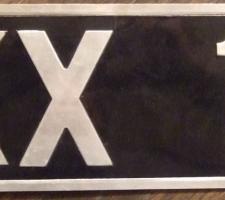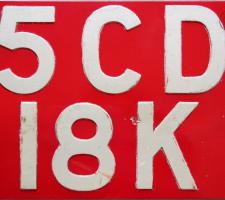Shem Oirere looks at Kenya’s plans to introduce a new generation of vehicle registration plates fitted with microchip technology by the end of this year.
In a move to improve driving standards and prevent fraud, the authorities in Kenya are planning the introduction of a new numberplate system which will incorporate microchip technology. Michael Kamau, Kenya’s transport secretary, said the new numberplates will have enhanced security features, enabled by latest laser technology making it impossible to forge or tamper with vehicle and ownership identity. “A microchip capturing crucial details of the owner, engine, colour, manufacture information and chassis numbers including logbook, will be embedded in the new numberplate. This will enable motor vehicle agencies to easily share data about a vehicle for whatever service is demanded of them,” he said.
“Even if you go and pluck off the numberplate, you will still not be able to access the gadget that is on the windscreen; so you cannot just interchange the numberplate.”
He said the technology will be able to relate with the number on the windscreen with information like the owner of the vehicle, the number of the vehicle and any other security features that will be incorporated. Kamau said since engines form part of the security details contained in the fitted microchip, a motorist who intends to change his vehicle’s engine: would have first to notify the registrar of motor vehicles of the change so that the security features on the numberplate are adjusted to reflect the new status.
“It will be difficult for somebody to just interchange a vehicle’s numberplate because with the data captured by the microchip, police officers will be able to easily detect it,” he added.
The Cabinet secretary also said the enhanced security features will deter fraudsters who use their vehicles as collateral to acquire loans only to later change the numberplates and logbook details to evade repayment.
“This fraud of evading repayment of loans acquired using logbooks has been happening in the past but it is one of the things these security features will bring to an end,” he said.
The head of National Transport and Safety Authority Lee Kinyanjui said the long- term plan of the police and the Kenya Revenue Authority is the installation of a central computer data capturing centre.
Initially the chips will be read manually by the police during spot checks to establish if the plates and/or vehicle are in violation of any law rather than regular reading of the chip as the vehicle drives along the highway.
However, Kinyanjui said his agency will be installing enough speed cameras on selected highways to curb road carnage and arrest speeding motorists. He could not confirm whether, in addition to monitoring speed, the cameras will also be used to ‘read’ the electronic numberplates. The introduction of the new-look numberplates is part of the ongoing reforms in the transport sub-sector which include automation of transport services under the Transport Integrated Management System (TIMS) to improve information sharing among agencies in the transport sector and enhance service delivery.
The electronic numberplates will cost $22.99 each and will be manufactured by Kenya Prisons Service, the country’s correctional services department. They will be fitted to all the estimated two million vehicles on Kenya’s roads.
Earlier, Kamau had announced the purchase of two new machines at the cost of $172,000 for the manufacture of the numberplates. The machines are being imported from Germany and will be installed at Kamiti Maximum Security Prison in Nairobi.
He said the Ministry of Transport, the National Transport and Safety Authority and Kenya Revenue Authority are working jointly on a transition schedule that will give vehicle owners adequate time to change from their current registration plates to the new technologysavvy numberplate regime.
This will be the first time in eight years that Kenya’s Ministry of Transport has moved to firm the proposal for microchip-fitted numberplates. The proposal was first floated by former transport minister John Michuki to counter what he said was rising crime involving vehicles with fake numberplates.
The microchip-fitted numberplates will be the biggest change in Kenya’s motor vehicle registration regime since 1938 when the first generation numberplates, with the series KAA 001 to KZZ 999, was introduced.
Kenya unveiled the microchip-fitted numberplates to coincide with plans to issue smart driving licences and both moves form part of an integrated transport management system.
The project is in its final stages of development and it is set to improve efficiency in Kenya’s transport sector according to Lee Kinyanjui, chairman of the National Transport and Safety Authority. “We will start interlinking all road transport and related agencies to enable them to share and process information,” he said in March.
He added that the new driving licenses will carry a chip with the holder’s personal information – ID number, contacts, past traffic offences and fines paid over time.
“Upon deployment of the system, traffic police would acquire equipment to read licences. The system keeps track of accumulated felonies and it will therefore be instrumental in limiting accidents and reckless driving on Kenyan roads.”
Kinyanjui added that it would be harder to replicate or forge the number plates and licences.
The smart driving licences will operate a demerit point system whereby a driver’s traffic offences will be accumulated and over time ultimately individuals can be barred from driving.
Early this year, the government banned the use of customised numberplates, saying it was illegal and had created avenues for manufacturers of fake number plates.
Only the country’s prisons department has been contracted to manufacture numberplates for the government. Former Registrar of Motor Vehicles Francis Meja said Section 17 of Kenya’s Traffic Act outlaws prescribed numberplates. Several politicians, sports and showbiz personalities had acquired customised number plates which bore their names.
“No one is allowed to manufacture number plates without the consent of the Registrar of Motor Vehicles. It is totally illegal and those with number plates with people’s names are not known to the government,” said Meja.
Kenya’s vehicle population has been increasing rapidly. According to Kenya National Bureau of Statistics, in 2011 new vehicle registrations hit 205,841, an almost fourfold increase from the 52,817 registered in 2006. Also in 2011 there were an estimated 1,626,380 vehicles on Kenya’s roads.
Despite the planned change of the numberplate registration system, Kenya still faces the challenge of supplying enough of the existing numberplates for new vehicles and some vehicles have been held at the port of Mombasa for many months.
According to Kenya Auto Bazaar (Kaba), the umbrella body for used car importers, there are persistent delays in issuance of new numberplates by the Kenya Revenue Authority which is costly to the vehicle importers.
“We have been facing heavy storage charges as the cars cannot be removed from the port without the numberplates,” said Kaba secretary Charles Munyori.
The transition to Kenya’s new numberplate system may not run as smoothly as in some other countries but the gains from doing so should be significant.
KENYAN REGISTRATION PLATES
According to Alec Davis of Kenya’s Vintage and Classic Car Club, the introduction of the K in the numberplates in 1938 marked major shifts in the numbering system occasioned by a surge in the number of vehicle owners who sought official registration of their vehicles.
The first generation numberplates were introduced on a regional basis catering for the regions of Nairobi, Mombasa, Nakuru, Kisumu and Nanyuki. Other regions such as Kisii, Kericho, Eldoret and Kitale were also later issued with their own series. In1980, the Kenyan government centralised the vehicl registration system ahead of the second generation numberplates in 1989.
The second generation series used black lettering on white plates with an additional suffix letter (similar to UK suffix style registrations) replaced the original plates which were black with white or silver lettering. At least 575,424 vehicles could be registered under this second generation numberplate system.
Kenya introduced a third generation of numberplates in 2007 with the series of KBA001A to KBZ999Z. Government vehicles use GK, Kenya Defence Forces use KA (Kenya Army), KAF (Kenya Airforce) and KN (Kenya Navy) while diplomats use CD.













